Several weeks ago I mentioned what a shame it is that, in our Orthodox Sunday lectionary, we never hear the lovely story of the Wedding at Cana, and I promised an article about it soon – and here it is!
A Digression about Pentecost and Weddings
By chance I placed this Post at the right time, liturgically. In small towns among the Jews, most weddings took place during the summer dry season, beginning after the spring harvest festival, Shavuot. Shavuot is the Jewish “Feast of Weeks”, concluding the seven weeks after Passover – otherwise known, by translation into Greek, as Pentecost. (“Pende” in Greek means “fifty”). Is this where our tradition of June weddings came from?
So you see, the Lord’s timing of Pascha (“Passover”) and Pentecost came right out of the Old Testament.
Jews came to Jerusalem from all over to celebrate Shavuot/Pentecost. That explains why on that day “there were staying in Jerusalem God-fearing Jews from every nation under heaven” (Acts 2:5) and who heard the Apostles miraculously preach to them in their own languages – and then heard Peter for the first time proclaim the Gospel of Jesus Christ.
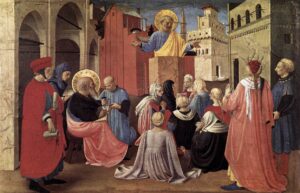
This is a late Medieval Western painting. Do any here present know who the artist was? *
* See the comments at the end of this Post.
So let’s go to the Wedding.

from the Greek Orthodox Archdiocese
The Wedding at Cana: John 2:1-12
On the third day there was a wedding in Cana of Galilee, and the mother of Jesus was there. Now both Jesus and His disciples were invited to the wedding. And when they ran out of wine, the mother of Jesus said to Him, “They have no wine.”
Jesus said to her, “Woman, what does your concern have to do with Me? My hour has not yet come.” His mother said to the servants, “Whatever He says to you, do it“. Now there were set there six waterpots of stone, according to the manner of purification of the Jews, containing twenty or thirty gallons apiece.
Jesus said to them, “Fill the waterpots with water.” And they filled them up to the brim. And He said to them, “Draw some out now, and take it to the master of the feast.” And they took it. When the master of the feast had tasted the water that was made wine, and did not know where it came from (but the servants who had drawn the water knew), the master of the feast called the bridegroom. And he said to him, “Every man at the beginning sets out the good wine, and when the guests have well drunk, then the inferior. You have kept the good wine until now!”
This was the first of the signs Jesus did in Cana of Galilee, and manifested His glory; and His disciples believed in Him. After this He went down to Capernaum, He, His mother, His brothers, and His disciples.
_______________________________________________________________
A Meandering Introduction

First a little geography: Apparently little is known about First Century Cana. Most scholars think it is now the town of 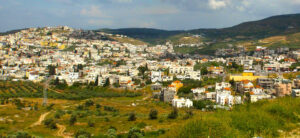 Kafr Kanna in Upper Galilee, about seven kilometres (4.3 miles) north of Nazareth. Capernaum was Christ’s “headquarters” during His ministry.
Kafr Kanna in Upper Galilee, about seven kilometres (4.3 miles) north of Nazareth. Capernaum was Christ’s “headquarters” during His ministry.
Below is the Orthodox Church in present-day Cana. Note above the door is an icon of the Wedding. There’s also a Roman Catholic Church there. (They can write their own Blog and show their own picture.)
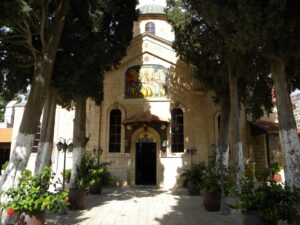
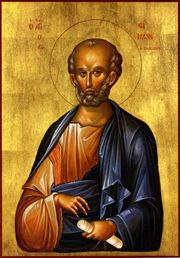
Early tradition says the bridegroom at the wedding was Simon, who became the Apostle Simon the Zealot – a nickname given him earlier because he was “zealous for the Law of Moses”. We may hope that he didn’t go following after Jesus until a while after the wedding! Then maybe he was one of the Apostles who took his wife along with him. (See 1 Corinthians 9:5.) I wish we had a picture of her, too.
with permission of St Isaac’s Skete: skete.com
The text begins: “On the third day….” The third day after what? I’ll save you having to look it up. Three days before, Jesus had seen Nathanael (probably also known as Bartholomew) hidden under the fig tree, and Nathanael had become a disciple. In the lovely story of the Lord’s post-resurrection “picnic breakfast” with the disciples, we learn that Nathanael also was from Cana.
John says the Cana miracle was the first of Christ’s “Signs” – Signs pointing into the Kingdom of Heaven, showing us what Heaven is like.
An Equally Meandering Commentary on the Text
“The Mother of Jesus was there”, as well as Jesus and His disciples. Were Mary and her Son related to the bride or groom? Perhaps. However, everybody came to weddings in small towns in those days – friends, family, everybody. They still do.
When I was staying at a taverna in small town Greece, once the owner went to be koumbaro (“best man”) at a wedding and never staggered back home till about 5 the next morning. Later, after he had recovered, I asked “How many were at the wedding?” He said “A couple hundred.” I asked “Was this a special wedding of some sort?” He said “No, just a normal wedding.”
Back to Cana: People were apparently drinking more than anticipated. The Mother of Jesus said to Him, “They’ve run out of wine”.
Now, why did she say this? Obviously because she already knew what He could do. There are apocryphal stories about how, when He was a boy, Jesus made muddy water clear; made clay sparrows and had them fly away! how he raised a boy from death, and the like. The Church has never officially accepted these stories. However He must have done something. That’s the only possible explanation for their dialog. That is why He responded, “Woman, what does that have to do with Me? * My time hasn’t come yet.” (“I’m not ready to start doing miracles in public.”)
- The usual English translation “Woman” makes Him sound nasty, missing the original meaning of the word. It is better translated “Ma’am” or something like that. As I read it, it suggests a sort of mannerly, loving disagreement – and a good natured, give-and-take relationship between the two of them. Other translations then say “What do I have to do with you?”, which may be literal, but is another example of 1) the difficulty with literal translations, 2) how words can mean different things depending on tone of voice and expression on face. “No” can mean a hundred different things, depending…
Surely the Lord wanted to do something significant for His first public miracle – a healing or raising someone from the dead or something like that. But “Mother, I do not want to begin my miracles by making wine for a party. Really! What’s that going to look like?”
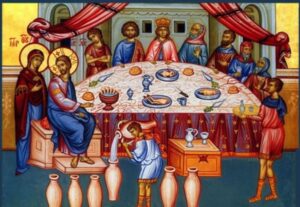
Pravmir
His Mother ignores what He said! She simply turns to the servants and says “Do what He tells you.” And without arguing back, He does it! He, Christ our God, Lord of Heaven and Earth, now an adult Man age thirty, meekly does what His Mother tells Him!
In the Orthodox and Roman Catholic traditions, there are hymns and prayers addressed to the Virgin Mary, asking her to intercede with her Son because a mother has the power to convince a son to do this or that. Now do you see where that idea comes from?
Protestants consider this just wrong: they believe talking to saints is impossible and off the wall, not to mention idolatrous.
I think many Orthodox also may find it hard to understand. After all, Christ our God is all-good, all-holy. Why does He need anyone to convince Him to do the right thing? I, as a convert to the Orthodox Church, also found it difficult – until I read the story of the Wedding in Cana again in this light. She did it at Cana, did she not? Why shouldn’t she continue to do it? talk her Son into doing something. Certainly never something contrary to His Holy Will, but rather helping Him to see that something actually is in accord with His Holy Will.
Does that sort of thing really go on in the Highest Heaven? Why not? (I don’t mean that as a superficial comment.) Does Christ still have a human Body in Heaven? Yes. Does the Theotokos still have a body in Heaven? Apparently so. (No matter [no pun intended], I don’t think our ordinary earthly concepts of “matter” fit in up there, as evidenced by Christ’s Resurrection Body.) So why shouldn’t they still be talking back and forth like the human beings they are? I think we often tend to “over-spiritualize” Heaven. Numerous icons show Christ and His Mother together presiding in the Kingdom. However, she holds her little Son, who is blessing, showing Who is ultimately in charge here.

Saint Isaac’s Skete
Back to the story: Why did the Lord listen to her? What convinced Him that she was right? that this was the thing He should do for His first Sign? It was our son David’s godmother who gave me the answer, many years ago. Jesus did it out of sheer kindness, to save a friend from embarrassment at his wedding. What is our Lord Jesus like? He is kind. What will the Kingdom of God be like? It will be filled with kindness. That was indeed the most significant thing Christ could show with His first Sign: God’s kindness.
From the Epistle for the feast of the Theophany: “But when the kindness and the love of God our Savior toward man appeared, not by works of righteousness which we have done, but according to His mercy He saved us… Titus 3:4-5
Just as Christ did at His birth, here also at Cana, He “manifested His glory” quietly, behind the scenes. “Only the servants knew” about it. And “His disciples believed”. Because they were there at the time? Maybe. Maybe not. Maybe they were having a good time at the party and later heard about it from John “the beloved disciple” who was always so close with Jesus. That might explain why none of the other Gospels have this story, but the Gospel according to John does. Just guessing.
Moving ahead:
There were six waterpots there containing twenty or thirty gallons apiece. The Lord made between 120 and 180 gallons of wine! (Brothers and sisters, I told you this was a big wedding reception.) And this was after the guests had already drunk God only knows how much. Jesus ordered that they fill them with water, and… “But…but, I know we put water in there. But now it’s… it’s wine!” *
- I’ve never figured out how teetotaling Christians deal with this. Fifty years ago at the Methodist seminary we attended, a young woman I was dating got suspended because she got caught having a beer! (I didn’t go along with them that evening, only because I had an exam next morning, or else…) So I guess they would have suspended the Lord Jesus, too! Or maybe they thought He didn’t actually drink it – He only made it for parties! At the time the seminary was inconsistently sliding liberal (or something), so that they allowed disbelief in Jesus, but did not allow beer.
Now, the servants knew the miracle Christ had performed, but the Master of the Feast did not. What was a “Master of the Feast”? Have you ever heard of “Wedding Planners”? (If not, search, and a huge number will come up. Here in Milwaukee, I counted up to 50 and gave up counting.) With a wedding reception that big, someone had to be in charge of it all.
When he tasted the fresh wine, the Master of the Feast said: “Every man at the beginning sets out the good wine, and when the guests have well drunk, then the inferior. You have kept the good wine until now!” You can figure that out. After the guests had become a little “tipsy”, as we used to say, they were no longer paying much attention to the quality of the wine. But how remarkable: You gave them good wine first, and even better wine now!
Do you see here the Sign of the Kingdom of Heaven? Despite our many troubles in this life, the Lord has also given us so many good things here, wonderfully good things.
 Look: “the sun in the morning and the moon at night”, gorgeous colors, the beauty of spring, which up here in the northland comes (eventually) with such green intensity that I find myself just staring out the window, taking it all in. Lakes, mountains…
Look: “the sun in the morning and the moon at night”, gorgeous colors, the beauty of spring, which up here in the northland comes (eventually) with such green intensity that I find myself just staring out the window, taking it all in. Lakes, mountains…
Wisconsin, of course
Listen: The voices of my wife and my children and my friends. YouTube (for all its many faults) gives me hours of gorgeous music from all over the world. The chirp of birds. The rush of waves, Today, as I write, the rush of the summer wind blowing through the trees.
The fragrances of spring and the summer, and of incense in church.
The taste of good food and wine. And chocolate!
Dear ones, I don’t mean to overdo this, but really I think it cannot be “overdone” – there is so much “good wine” God has given us now here on earth, “at the beginning”.
But Christ is saving the “best wine” for later, for the Kingdom of Heaven. At my age, every year I wonder if I’ll see another spring, which I easily might not, and I feel “bitter-sweet” – till I remember that this is the lesser “wine”. He has saved the truly “Good Wine” till last, better than we can even imagine: “Eye has not seen, nor ear heard, nor have entered into the heart of man the things which God has prepared for those who love Him.” 1 Corinthians 2:9
And of course there are Eucharistic overtones in the story. Let me say this very carefully: The Divine Liturgy with the Holy Eucharist is the holiest thing, the best thing on earth. But it is not the Best Thing. It is only the foretaste of the Great Banquet in the Kingdom of Heaven. Our Lord Jesus Christ has saved the Best Wine till the Last.
“After this He went down to Capernaum, He, His mother, His brothers, and His disciples.” She and the rest of His family did not go back to Nazareth, which was much closer. They went with Him down to His Capernaum headquarters, even farther from their home.
I wonder how long His Blessed Mother stayed there. I wonder how much time she spent with Him that we don’t know about. I wonder how often she helped Him to see what He really wanted to do. I wonder how often she still does.
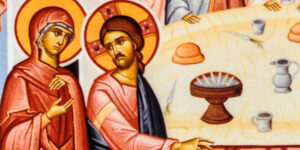
Next two weeks: Abortion revisited, based on two Posts from about five years ago
The painting is “St Peter Preaching in the Presence of St Mark” by Fra Angelico: https://commons.wikimedia.org/wiki/File:Fra_Angelico_-_St_Peter_Preaching_in_the_Presence_of_St_Mark_-_WGA00464.jpg
Thank you, Valery and Alexander, for the information.
Dear Father,
Thank you for this wonderful post. To answer your question- the first painting is called “St. Peter Preaching in the Presence of St. Mark” by Fra Angelico (found via Google lens)
https://www.wikiart.org/en/fra-angelico/st-peter-preaching-in-the-presence-of-st-mark
Best wishes,
Valery
Thank you, for this good post, Father Bill. I have a question: How could they go “down” to Capernaum, which is to the north? is it because Capernaum is at a lower elevation, since it is by the Sea of Galilee?
You read things very carefully! and you’ve got it right. Nazareth and Cana are “up” in the hills. Capernaum is “down” by the Sea of Galilee, which is about 700 feet below sea level. (For the same reason, “Upper Egypt” is in the south, while “Lower Egypt” is in the north.)
Thank you, Father Bill. I would appreciate visiting the Holy Land, with my wife, someday.